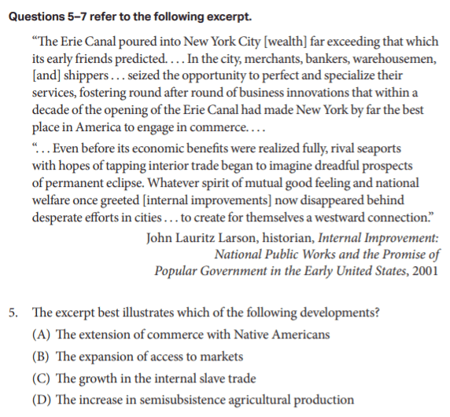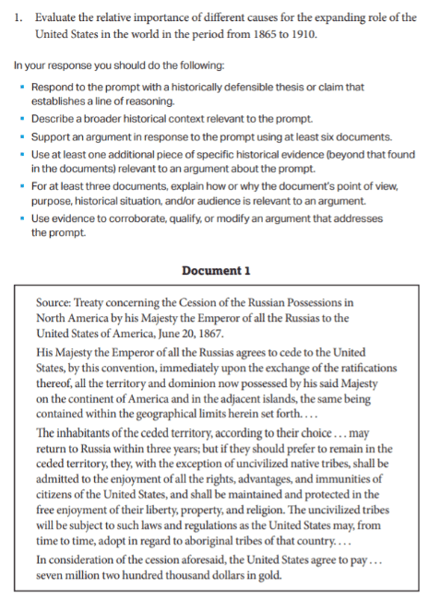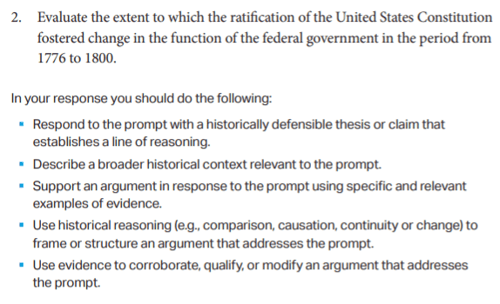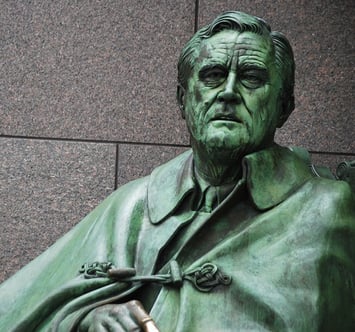- Articles of Confederation
- Monroe Doctrine
- Prohibition
- Imperialism
- Expansionism
- Manifest destiny

List of Document Based Questions
- Edit source
- View history
- 6 2010
The APUSH exam underwent a major redesiee-response portion now only contains one DBQ and one LEQ (from a choice of two).
- DBQ: Explain the reasons why a new conservatism rose to prominence in the United States between 1960 and 1989.
- ... relations with Great Britain, analyzing what changed and what stayed the same from the period before the war to the period after it.
- Evaluate the extent to which the Mexican-American War (1846–1848) marked a turning point in the debate over slavery in the United States, analyzing what changed and what stayed the same from the period before the war to the period after it.
- DBQ: How and why did the goals of United States foreign policy change from the end of the First World War (1918) to the end of the Korean War (1953)?
- Choose TWO of the following and analyze their impact on colonial North American development between 1620 and 1776: Puritanism, The Enlightenment, The First Great Awakening
- Compare and contrast the Jacksonian Democratic Party and the Whig Party of the 1830's and 1840's. Focus on TWO of the following: The role of the federal government in the economy, Social reform, Westward expansion
- To what extent were the goals of Reconstruction (1865–1877) regarding African Americans achieved by 1900?
- Explain the social, economic, and foreign policy goals of New Right conservatives from the 1960's to the 1980's and assess the degree to which the Reagan administration succeeded in implementing these goals in the 1980's.
- DBQ: Analyze the causes of growing opposition to slavery in the United States from 1776 to 1852. In your response, consider both underlying forces and specific events that contributed to the growing opposition.
- Analyze the role of trans-Atlantic trade and Great Britain’s mercantilist policies in the economic development of the British North American colonies in the period from 1650 to 1750.
- Analyze the ways in which the United States sought to advance its interests in world affairs between 1789 and 1823.
- Analyze the impact of technological innovations on the lives of TWO of the following groups. Confine your answer to the period 1865–1920: Factory workers, Middle-class urban residents, Mid-western farmers.
- Between 1945 and 1975 various groups in the United States engaged in acts of protest. Analyze the reasons that protest emerged in this period for TWO of the following groups: African Americans, College students, Latino Americans, Women.
- DBQ: In the post–Civil War United States, corporations grew significantly in number, size, and influence. Analyze the impact of big business on the economy and politics and the responses of Americans to these changes. Confine your answer to the period 1870 to 1900.
- Analyze the effect of the French and Indian War and its aftermath on the relationship between Great Britain and the British colonies. Confine your response to the period from 1754 to 1776.
- Analyze how western expansion contributed to growing sectional tensions between the North and the South. Confine your answer to the period from 1800 to 1850.
- Analyze the origins and outcomes of the intense cultural conflicts of the 1920's. In your response, focus on TWO of the following: Immigration, Prohibition, Religion.
- Compare and contrast the Cold War foreign policies of TWO of the following presidents: Harry Truman (1945–1953), Dwight Eisenhower (1953–1961), Richard Nixon (1969–1974).
- DBQ: Analyze the international and domestic challenges the United States faced between 1968 and 1974, and evaluate how President Richard Nixon’s administration responded to them.
- Analyze the origins and development of slavery in Britain’s North American colonies in the period 1607 to 1776.
- To what extent did political parties contribute to the development of national unity in the United States between 1790 and 1840?
- Compare and contrast the ways that many Americans expressed their opposition to immigrants in the 1840's– 1850's with the ways that many Americans expressed their opposition to immigrants in the 1910's– 1920's.
- African American leaders have responded to racial discrimination in the United States in a variety of ways. Compare and contrast the goals and strategies of African American leaders in the 1890's–1920's with the goals and strategies of African American leaders in the 1950's-1960's.
- DBQ: Explain the ways that participation in political campaigns and elections in the United States changed between 1815 and 1840, and analyze forces and events that led to these changes.
- Compare and contrast the British, French, and Spanish imperial goals in North America between 1580 and 1763.
- Analyze the ways in which the political, economic, and diplomatic crises of the 1780's shaped the provisions of the United States Constitution.'
- Compare and contrast the foreign policies of Theodore Roosevelt and Woodrow Wilson.
- Compare and contrast the women’s rights movement of the 1840's–1860's with the women’s rights movement of the 1960's–1980's.
2010 [ ]
- DBQ: In what ways did ideas and values held by the Puritans influence the political, economic, and social development of the New England colonies from 1630 through the 1660's?
- Analyze the political, diplomatic, and military reasons for the United States victory in the Revolutionary War. Confine your answer to the period 1775-1783.
- Analyze the ways in which controversy over the extension of slavery into western territories contributed to the coming of the Civil War. Confine your answer to the period 1845-1861.
- Analyze the roles that women played in the Progressive Era reforms from the 1880's through 1920. Focus your essay on TWO of the following: Politics, Social conditions, Labor and working conditions.
- Explain the causes and consequences of TWO of the following population movements in the United States during the period 1945–1985: Suburbanization, The growth of the Sunbelt, Immigration to the United States.
- DBQ: The issue of territorial expansion sparked considerable debate in the period 1800–1855. Analyze this debate and evaluate the influence of both supporters and opponents of territorial expansion in shaping federal government policy. Use the documents and your knowledge of the years 1800–1855 in your answer.
- Evaluate the influence of religion on the development of colonial society in TWO of the following regions: The Spanish Southwest, New England, New France.
- Compare and contrast the experience of slaves on tobacco plantations in the early seventeenth-century Chesapeake region with that of slaves on nineteenth-century cotton plantations in the Deep South. What forces transformed the institution of slavery from the early seventeenth century to the nineteenth century?
- Analyze the effectiveness of Progressive Era reformers in addressing problems of the late nineteenth and early twentieth centuries. In your answer, focus on reform efforts in TWO of the following areas: State and federal government, The workplace, Living conditions in cities.
- Analyze the effects of the Vietnam War on TWO of the following in the United States in the period from 1961 to 1975: The presidency, The population between 18 and 35 years old, Cold War diplomacy.
- DBQ: From 1775 to 1830, many African Americans gained freedom from slavery, yet during the same period the institution of slavery expanded. Explain why BOTH of those changes took place. Analyze the ways that BOTH free African Americans and enslaved African Americans responded to the challenges confronting them.
- Analyze the ways in which British imperial policies between 1763 and 1776 intensified colonials' resistance to British rule and their comitment to republican values.
- Analyze the social, political, and economic forces of the 1840s and early 1850s that led to the emergence of the Republican Party.
- Choose TWO of the following organizations and explain their strategies for advancing the interests of workers. To what extent were these organizations successful in achieving their objectives? Confine your answers to the period from 1875 to 1925. Choices: Knights of Labor, American Federation of Labor, Socialist Part of America, Industrial Workers of the World.
- Analyze the home-front experiences of TWO of the following groups during the Second World War: African Americans, Japanese Americans, Jewish Americans, Mexican Americans.
- DBQ: In what ways did African Americans shape the course and consequences of the Civil War? Confine your answer to the years from 1861 to 1870.
- Analyze how the ideas and experiences of the revolutionary era influenced the principles embodied in the Articles of Confederation.
- Analyze the political, economic, and religious tensions between immigrant Roman Catholics and native-born Protestants in the United States from the 1830s through the 1850s.
- Explain the origins of TWO of the following third parties and evaluate their impact on United States politics and national policies: The People's Party (Populists) in 1892, the Progressive Party (Bull Moose Party) in 1912, the States' Rights Party (Dixiecrats) in 1948, the American Independent Party in 1968.
- Analyze the ways in which the events and trends of the 1970s diminished the nation's economic power and international influence, and challenged Americans' confidence in both.
- DBQ: Analyze the ways in which the Vietnam War heightened social, political, and economic tensions in the United States. Focus your answer on the period 1964 to 1975.
- Early encofghvand, Chesapeake, Spanish Southwest, California and New France.
- Analyze the impact of the market ratchets (1815-1860) on the economies of TWO of the following regions: the Northeast, the Midwest, the South.
- Following Reconstruction, many southern leaders promoted the idea of a "New South." To what extent was the "New South" a reality by the time of the First World War? In your answer be sure to address TWO of the following: Economic development, Politics, Race relations.
- Presidential elections between 1928 and 1948 revealed major shifts in political party loyalties. Analyze both the reasons for these changes and their consequences during this period.
- DBQ: For the years 1880 to 1925, analyze both the tensions surrounding the issue of immigration and the United States government's response to these tensions. Use the following documents and your knowledge of the period from 1880 to 1925 to construct your answer.
- Analyze the reasons for the Anti-Federalists' opposition to ratifying the Constitution.
- Use TWO of the following categories to analyze the ways in which African Americans created a distinctive culture in slavery: Family, Music, Oral traditions, Religions.
- Analyze the extent to which the Spanish-American War was a turning point in American foreign policy.
- Analyze the extent to which the 1920s and 1950s were similar in TWO of the following areas: Impact of technology, Intolerant attitudes, Literary developments.
- DBQ: Analyze the ways in which technology, government policy, and economic conditions changed American agriculture in the period 1865-1900. In your answer be sure to evaluate farmers' responses to these changes.
- Settlers in the eighteenth-century American back country sometimes resorted to violent protest to express their grievances. Analyze the causes and significance of TWO of the following: March of the Paxton Boys, Regulator movement, Shays' Rebellion, Whiskey Rebellion.
- In what ways did the Second Great Awakening in the North influence TWO of the following? Abolitionism, Temperance, the Cult of Domesticity, Utopian communities.
- To what extent did the role of the federal government change under President Theodore Roosevelt in regard to TWO of the following: Labor, Trusts, Conservation, World affairs.
- "Landslide presidential victories do not ensure continued political effectiveness or legislative success." Assess the validity of this statement by comparing TWO of the following presidential administration: Franklin Roosevelt (1936), Lyndon Johnson (1964), Richard Nixon (1972), Ronald Reagan (1984).
- DBQ: In what ways did the administration of President Lyndon B. Johnson respond to the political, economic, and social problems of the United States? Assess the effectiveness of these responses. Use the documents and your knowledge of the period 1960-1970 to construct your response.
- The French and Indian War (1754-1763) altered the relationship between Britain and its North American colonies. Assess this change with regard to TWO of the following in the period between 1763 and 1775: Land acquisition, Politics, Economics.
- Compare the experiences of TWO of the following groups of immigrants during the period 1830 to 1860: English, Irish, German.
- Explain how TWO of the following individuals responded to the economic and social problems created by industrialization during the late nineteenth and early twentieth centuries: Jane Addams, Andrew Carnegie, Samuel Gompers, Upton Sinclair.
- Analyze the ways in which the federal government sought support on the home front for the war effort during the First World War.
- DBQ: Discuss the changing ideals of American womanhood between the American Revolution (1770s) and the outbreak of the Civil War. What factors fostered the emergence of "republican motherhood" and the "cult of domesticity?" Assess the extent to which these ideals influenced the lives of women during this period. In your answer be sure to consider issues of race and class.
- Analyze the differences between the Spanish settlements in the Southwest and the English colonies in New England in the seventeenth century in terms of TWO of the following: Politics, Religion, Economic development.
- Explain why and how the role of the federal government changed as a result of the Civil War with respect to TWO of the following during the period 1861-1877.
- Historians have argued that Progressive reform lost momentum in the 1920s. Evaluate this statement with respect to TWO of the following: Regulation of business, Labor, Immigrants.
- While the United States appeared to be dominated by consensus and conformity in the 1950s, some Americans reacted against the status quo. Analyze the critiques of United States society made by TWO of the following: Youth, Civil Rights Activists, Intellectuals.
- DBQ: Analyze developments from 1941 to 1949 that increased suspicion and tension between the United States and the Soviet Union. Use the documents and your knowledge of the period 1941-1949 to construct your response.
- "The United States Constitution of 1787 represented an economic and ideological victory for the traditional American political elite." Assess the validity of that statement for the period 1781 to 1789.
- In what ways and to what extent was industrial development from 1800 to 1860 a factor in the relationship between the northern and the southern states?
- For whom and to what extent was the American West a land of opportunity from 1865 to 1890?
- How did TWO of the following help shape American national culture in the 1920s? Advertising, Entertainment, Mass production.
- DBQ: To what extent did the American Revolution fundamentally change American society? In your answer, be sure to address the political, social, and economic effects of the Revolution in the period from 1775 to 1800.
- Compare and contrast the ways in which economic development affected politics in Massachusetts and Virginia in the period from 1607 to 1750.
- To what extent did the debates about the Mexican War and its aftermath reflect the sectional interests of New Englanders, westerners, and southerners in the period from 1845 to 1855?
- Describe the patterns of immigration in TWO of the periods listed below. Compare and contrast the responses of Americans to immigrants in these periods: 1820 to 1860, 1880 to 1924, 1965 to 2000.
- Analyze the extent to which TWO of the following transformed American society in the 1960s and 1970s: The Civil Rights movement, the antiwar movement, the women's movement.
- DBQ: In the early nineteenth century, Americans sought to resolve their political disputes through compromise, yet by 1860 this no longer seemed possible. Analyze the reasons for this change. Use the documents and your knowledge of the period 1820-1860 in constructing your response.
- "Geography was the primary factor in shaping the development of the British colonies in North America." Assess the validity of this statement for the 1600s.
- To what extent was the United States Constitution a radical departure from the Articles of Confederation?
- How successful were progressive reforms during the period 1890 to 1915 with respect to TWO of the following? Industrial conditions, Urban life, Politics.
- Analyze the ways in which TWO of the following contributed to the changes in women's lives in the United States in the mid-twentieth century: Wars, Literature and/or popular culture, Medical and/or technological advances.
- DBQ: In what ways did the French and Indian War (1754-63) alter the political, economic, and ideological relations between Britain and its American colonies? Use the documents and your knowledge of the period 1740-1766 in constructing your response.
- Analyze the impact of the American Revolution of the both slavery and the status of women in the period from 1775-1800.
- Analyze the effectiveness of political compromise in reducing sectional tensions in the period 1820 to 1861.
- Compare and contrast the programs and policies designed by reformers of the Progressive era to those designed by reformers of the New jkhkDeal period. Confine your answers to programs and policies that addressed the needs of those living in poverty.
- Analyze the successes and failures of the United States Cold War policy of containment as it developed in TWO of the follow regions of the world during the period 1945 to 1975: East and Southeast Asia, Europe, Latin America, Middle East.
- DBQ: How and for what reasons did the United States foreign policy change between 1920 and 1941? Use the documents and your knowledge of the period 1920-1941 to construct your response.
- To what extent was the election of 1800 aptly named the "Revolution of 1800?" Respond with reference to TWO of the following areas: Economics, Foreign policy, Judiciary, Politics.
- To what extent and in what ways did the roles of women change in American society between 1790 and 1860? Respond with reference to TWO of the following areas: Domestic, Economic, Political, Social.
- Analyze the primary causes of the population shift from a rural to an urban environment in the United States between 1875 and 1925.
- "Between 1960 and 1975, there was great progress in the struggle for political and social equality." Assess the validity of this statement with respect to TWO of the following groups during that period: African Americans, Asian Americans, Latinos, Native Americans, Women.
- DBQ: Analyze the responses of Franklin D. Roosevelt's administration to the problems of the Great Depression. How effective were the responses? How did they change the role of the federal government? Use the documents and your knowledge of the period 1929-1941 to construct your essay.
- Evaluate the extent to which the Articles of Confederation were effective in solving the problems that confronted the new nation.
- In what ways did developments in transportation bring about economic and social change in the United States in the period 1820-1860?
- Evaluate the impact of the Civil War on political and economic developments in TWO of the following regions: The South, the North, the West. Focus your answer on the period between 1865 and 1900.
- Compare and contrast United States society in the 1920s and the 1950s with respect to TWO of the following: race relations, role of women, consumerism.
- DBQ: Evaluate the effectiveness of Progressive Era reformers and the federal government in bringing about reform at the national level. In your answer be sure to analyze the successes and limitation of these efforts in the period 1900-1920.
- Compare the ways in which TWO of the following reflected tensions in colonial society: Bacon's Rebellion (1676), Pueblo Revolt (1680), Salem witchcraft trials (1692), Stono Rebellion (1739)
- Although the power of the national government increased during the early republic, this development often faced serious opposition. Compare the motives and effectiveness of those opposed to the growing power of the national government in TWO of the following: Whiskey Rebellion (1794), Virginia and Kentucky Resolutions (1798-1799), Hartford Convention (1814-1815), Nullification Crisis (1832-1833).
- Analyze the ways in which farmers and industrial workers responded to industrialization in the Gilded Age (1865-1900).
- Describe and account for changes in the American presidency between 1960 and 1975, as symbolized by Kennedy's "Camelot," Johnson's Great Society, and Nixon's Watergate. In your answer, address the powers of the presidency and the role of the media.
- DBQ: "Reform movements in the United States sought to expand democratic ideals." Assess the validity of this statement with specific reference to the years 1825-1850.
- Compare the ways in which religion shaped the development of colonial society (to 1740) in TWO of the following regions: New England, Chesapeake, Middle Atlantic.
- Analyze the contribution of TWO of the following in helping establish a stable government after the adoption of the Constitution: John Adams, Thomas Jefferson, George Washington.
- Compare and contrast United States foreign policy after the First World War and after the Second World War. Consider the periods 1919-1928 and 1945-1950.
- How did the African American Civil Rights movement of the 1950s and 1960s address the failures of the Reconstruction?
- DBQ: Historians have traditionally labeled the period after the War of 1812 the "Era of Good Feelings." Evaluate the accuracy of this label, considering the emergence of nationalism and sectionalism. Use the documents and your knowledge of the period 1815-1825 to construct your answer.
- Analyze the impact of the Atlantic trade routes established in the mid 1600s on economic development in the British North American colonies. Consider the period 1650-1750.
- Identify and analyze the factors that changed the American city in the second half of the nineteenth century.
- How successful were the programs of the New Deal in solving the problems of the Great Depression? Assess with respect to TWO of the following: Relief, recovery, reform.
- Analyze the ways in which TWO of the following shaped American politics after the Second World War: Anticommunism in the 1940s and 1950s, the women's liberation movement in the 1960s, the "silent majority" in the 1970s.
- DBQ: What were the Cold War fears of the American people in the aftermath of the Second World War? How successfully did the administration of President Dwight D. Eisenhower address these fears?
- How did economic, geographic, and social factors encourage the growth of slavery as an important part of the economy of the southern colonies between 1607 and 1775?
- The Jacksonian Period (1824-1848) has been celebrated as the era of the "common man." To what extent did the period live up to its characterization? Consider TWO of the following in your response: Economic development, Politics, Reform movements.
- How and why did transportation developments spark economic growth during the period from 1860 to 1900 in the United States?
- Describe and account for the rise of nativism in American society from 1900 to 1930.
AP US History DBQ & FRQ
Ap us history dbq & frq.
There are some great online resources available for AP US History Document Based Questions and Free Response Questions. Review the list below to see all the best options.
Prior Year Free Response
Long essay video, short answer video, writing in apush, apush thesis statements, us history writing, writing guide.
AP US History | Practice Exams | FRQ & DBQ | Notes | Videos | Study Guides
MA in American History : Apply now and enroll in graduate courses with top historians this summer!
- AP US History Study Guide
- History U: Courses for High School Students
- History School: Summer Enrichment
- Lesson Plans
- Classroom Resources
- Spotlights on Primary Sources
- Professional Development (Academic Year)
- Professional Development (Summer)
- Book Breaks
- Inside the Vault
- Self-Paced Courses
- Browse All Resources
- Search by Issue
- Search by Essay
- Become a Member (Free)
- Monthly Offer (Free for Members)
- Program Information
- Scholarships and Financial Aid
- Applying and Enrolling
- Eligibility (In-Person)
- EduHam Online
- Hamilton Cast Read Alongs
- Official Website
- Press Coverage
- Veterans Legacy Program
- The Declaration at 250
- Black Lives in the Founding Era
- Celebrating American Historical Holidays
- Browse All Programs
- Donate Items to the Collection
- Search Our Catalog
- Research Guides
- Rights and Reproductions
- See Our Documents on Display
- Bring an Exhibition to Your Organization
- Interactive Exhibitions Online
- About the Transcription Program
- Civil War Letters
- Founding Era Newspapers
- College Fellowships in American History
- Scholarly Fellowship Program
- Richard Gilder History Prize
- David McCullough Essay Prize
- Affiliate School Scholarships
- Nominate a Teacher
- Eligibility
- State Winners
- National Winners
- Gilder Lehrman Lincoln Prize
- Gilder Lehrman Military History Prize
- George Washington Prize
- Frederick Douglass Book Prize
- Our Mission and History
- Annual Report
- Contact Information
- Student Advisory Council
- Teacher Advisory Council
- Board of Trustees
- Remembering Richard Gilder
- President's Council
- Scholarly Advisory Board
- Internships
- Our Partners
- Press Releases
How to DBQ | AP US History Study Guide
Learn how to respond to the Document-Based Essay Question.
Resources by Period:
- Period 1: 1491–1607
- Period 2: 1607–1754
- Period 3: 1754–1800
- Period 4: 1800–1848
- Period 5: 1844–1877
- Period 6: 1865–1898
- Period 7: 1890–1945
- Period 8: 1945–1980
- Period 9: 1980–Present
Stay up to date, and subscribe to our quarterly newsletter.
Learn how the Institute impacts history education through our work guiding teachers, energizing students, and supporting research.

AP® US History
Understanding the new ap® us history dbq rubric.
- The Albert Team
- Last Updated On: March 1, 2022

Just like a touchdown and extra point, the new AP® US History DBQ is worth seven points. The DBQ is 25% of your final score on the exam, so it is crucial for you to understand the changes to the rubric, as well as how to write the best DBQ possible.
Total Possible Points : 7 Thesis and Argument Development: 0-2 points
This strand of the rubric targets your historical argumentation skills. To do well on this strand, you must:
- Write a thesis that is “historically defensible” (i.e. that you can back up with historically accurate arguments. In other words, you must use facts )
- Respond to ALL parts of the question
- Use this thesis to develop a cogent argument that takes into account historical evidence AND demonstrates a relationship between different types of historical evidence
It is that last bullet point that may confound you the most. Remember, the question will be complex and ask about relationships between different types of evidence.
You may be asked to demonstrate how different types of evidence contradict one another, corroborate or strengthen one another, or change one another. The important thing is that you demonstrate a strong understanding of all the evidence as well as how each piece is related to the other.
A few more helpful tips…
You may be used to writing a standard five-paragraph essay with one opening paragraph, of which the thesis is the last line. Forget this style.
For a DBQ, you must locate your thesis in either the introduction OR conclusion of your essay, but remember: your intro and conclusion can be LONGER than one paragraph. This flexibility gives you room to write a thesis that explicitly addresses all parts of the question, makes an accurate and well-supported argument, and uses complex reasoning to illustrate historical relationships and reasoning. In other words, a thesis for a DBQ will never look like a spitback answer, like “World War One started on July 28, 1914.” You can expect your thesis to be longer than that, and in fact, the College Board takes into account that your thesis may well be longer than one sentence.
Document Analysis (0-2 points)
This strand of the rubric targets your ability to analyze evidence and use the evidence to support the argument laid out in your thesis.
The DBQ is comprised of multiple documents. These can include primary sources, secondary scholarship, images, text… You may not be familiar with all of the documents, but you must be able to use what you know (either background information or context clues from the documents themselves) in order to make a coherent historical argument that supports your thesis. You must use at least six of the documents to support your thesis.
Of those six, you must be able to explicitly explain four of the documents. An explicit explanation can comprise a discussion of:
- The point of view evinced in the document (what argument does this document support or negate?)
- The author’s purpose (what was the creator’s aim in writing or disseminating this document?)
- The historical context (where is this document coming from? What was it used for?)
- The audience (who was meant to see this document, and why?)
Again, all discussions of the documents must demonstrate that you can use the documents to strengthen your argument and support your thesis.

Using Evidence Beyond the Documents: 0-2 points
This skill targets your ability to contextualize and argue historically.
There are two strands here. Contextualization means that you must locate your argument within a larger historical context; i.e. you must explain how the argument connects to other historical events or processes.
So if the question is about, for example, warfare during the Civil War versus the French and Indian War, you must give enough background information about one or both of those events to convince the grader that you know what you are talking about when you make claims about one or both of those processes.
- When contextualizing, you will be using information you already know. You cannot merely summarize the information that is already in the documents, but must instead give an account of the relevant historical time periods or evidence.
- To properly contextualize, you will need to write more than just one sentence. The College Board expects at least a paragraph of contextualization, if not more.
Related to contextualization is your ability to give evidence from beyond the documents themselves. In other words, though you may have used outside evidence in the previous strand (Document Analysis), you must now refer to additional evidence that explains the documents and their relationship to your broader historical argument. Don’t just summarize information you have already given.
Again, to do this properly, you must be able to write at least a paragraph giving additional context on the specific documents. One sentence will not cut it.
Synthesis (0-1 point)
The final strand is your ability to synthesize. This just means that you can show a relationship between your argument and a different type of argument.
Those different “types” of argument can comprise of:
- A relevant development in a different time period, situation, area, or era. (For example, if the argument is about President Lincoln’s suspension of certain liberties during the Civil War, you might want to point to President Adams’ Alien and Sedition Acts of 1798, President Roosevelt’s Alien Enemies Act, which was in fact an extension of the 1798 Alien and Sedition Acts, and the continuing argument over government usurpation of civil liberties in the present day. These are relevant to one another and show continuity even though they happened in vastly different time periods in response to different issues.)
- A different approach to history (i.e. if your argument focuses on economic history, you may want to synthesize this with a social approach to history)
While the AP® World and AP® European history tests also award the synthesis point for your connection of your argument to a different field of study (anthropology, art history, government and politics, etc.), the AP® US History exam will only award the synthesis point in the cases outlined by the bullet points above.
As with contextualization, you can only earn a point for synthesis if your synthesis is well-developed and clear. In other words, you must do more than merely refer to a different historical time period, development, process, or approach.
You must instead write a well-thought-out paragraph (at least) that demonstrates that you are familiar both with the event/issue about which you are writing the essay as well as the event/issue/process/approach you are attempting to synthesize.
The DBQ can seem daunting. You are supposed to be able to juggle multiple skills (argumentation, contextualization, periodization, synthesis… as well as actual content knowledge) and use them all at once to make a concrete argument.
However, the more you practice, the easier this will become. Do not put pressure on yourself to write a perfect DBQ on your first, second, or third try. This rubric is broken into component skills so that you can test yourself on each one. While they are all related – and while no knowledge exists in a vacuum – give yourself the freedom to focus on different skills each time you practice. Don’t put pressure on yourself to do a perfect job right away. Instead, focus on one or two skills at a time.
Some helpful tips…
Though this question tests your ability to think and describe relationships and arguments in context of one another, there is no replacement for content knowledge.
Flashcards that list the salient facts about a big event (or relevant document) can be very helpful here.
Don’t get hung up on trivia like dates or names; it’s more important to be able to describe the point of the Alien and Sedition Acts than to be able to list the date they were passed.
With enough practice, you will be able to make a well-supported historical argument in time for the AP® exam. Spend time in and out of class practicing how to write these, and you might even come to enjoy the process come May.
For a more comprehensive article regarding the AP® US History DBQ, be sure to check out our How-To Guide here .
Looking for AP® US History practice?
Kickstart your AP® US History prep with Albert. Start your AP® exam prep today .
Interested in a school license?
Popular posts.

AP® Score Calculators
Simulate how different MCQ and FRQ scores translate into AP® scores

AP® Review Guides
The ultimate review guides for AP® subjects to help you plan and structure your prep.

Core Subject Review Guides
Review the most important topics in Physics and Algebra 1 .

SAT® Score Calculator
See how scores on each section impacts your overall SAT® score

ACT® Score Calculator
See how scores on each section impacts your overall ACT® score

Grammar Review Hub
Comprehensive review of grammar skills

AP® Posters
Download updated posters summarizing the main topics and structure for each AP® exam.
5+ Example APUSH DBQ Questions

One of the best ways to practice for the AP US History exam is by trying out sample questions. Sample APUSH DBQ questions help you get prepared to write a killer essay on test day.
APUSH DBQ Questions: An Overview
The APUSH DBQ consists of one essay question. You will have 55 minutes to complete the essay. The essay is graded on a 7-point rubric and will count for 25% of your overall exam score.
You will be presented with an essay question, followed by a series of documents (typically 7) related to the theme of the question. These documents can be any combination of primary and secondary source texts, maps, photographs, political cartoons, or other artwork.
You will need to use information from the documents as well as your outside knowledge to construct an essay response to the question. Your response should be a persuasive essay and must include a thesis statement backed by evidence.
Official APUSH DBQ Questions
The College Board has released several sample DBQs. These come from the official practice test and previous real exams. These official APUSH DBQ questions are the best, most reliable source to help you prepare for what to expect on test day. Read through these and try your hand at writing (or at least outlining) the essays. Some of them even come with scoring guides and sample student responses to help you see how you would have done if you’d written this essay for the real exam.
Here are links to the official APUSH DBQ questions:
Topic: Imperialism in the late 19th and early 20th centuries Source: Official AP US History Practice Test (p.32-35)
Topic: American Revolution Source: 2017 AP US History Exam (p. 7-11)
Topic: Women’s Rights Movement Source: 2016 AP US History Exam (p. 6-11) Related resources: Scoring guide and sample student responses
Topic: New Conservatism Source: 2015 AP US History Exam (p. 6-10) Related resources: Scoring guide and sample student responses
Unofficial APUSH DBQ Questions
There are several sources of unofficial DBQ questions. While these are less reliable than the official questions from College Board, they can provide good practice in interpreting and building an argument around documents.
Barron’s has a single free full-length practice test available on their website, which includes the DBQ. You can take the whole exam, or if you’re only interested in the DBQ, you can click on “Jump to Question” once inside the exam and select the DBQ. The topic is the Progressive Movement.
You can also find loads of good quality teacher-created practice APUSH DBQ questions online. For example, Mr. Bryant’s AP US History has a folder of TONS of DBQS you can download as Word documents. They are organized by time period/topic.
High quality test prep books from major publishers also include practice tests, including DBQs. Make sure you choose a book from 2015 or later to ensure the material is updated for the latest version of the APUSH exam.
More APUSH DBQ Resources
Check out these other great resources from Magoosh to help you prepare to shine on your APUSH DBQ questions:
- The AP US History DBQ: What You Should Know
- How to Prepare for the APUSH DBQ Section
- 3 Steps to an APUSH DBQ Essay that Works

Sarah is an educator and writer with a Master’s degree in education from Syracuse University who has helped students succeed on standardized tests since 2008. She loves reading, theater, and chasing around her two kids.
View all posts
More from Magoosh

Leave a Reply Cancel reply
Your email address will not be published. Required fields are marked *

Choose Your Test
Sat / act prep online guides and tips, the ultimate guide to the ap us history exam.
Advanced Placement (AP)

The AP US History exam involves critical reading, writing, and in-depth analysis. It's not just about memorizing names and dates, but rather interpreting historical evidence quickly and accurately, recalling outside information on a topic, and synthesizing your ideas into a coherent argument.
In this guide, we'll give you a rundown of the format and structure of the AP US History test along with a brief content outline, sample questions, and some tips for a great score .
How Is the AP US History Exam Structured?
The next AP US History test will be administered on Friday, May 5, 2023, at 8 AM . This AP exam is three hours and 15 minutes long and consists of two main sections, each of which is divided into a Part A and a Part B.
Before we get into the details of each part, here's an overview of the US History test as a whole:
Section 1, Part A: Multiple Choice
The first section on the test is the multiple-choice section, which is worth 40% of your score and lasts for 55 minutes. You'll get 55 questions, each with four possible answer choices (labeled A-D); this means that you'll have about a minute per question on this part of the exam.
Most US History multiple-choice questions come in sets of three to four questions that require you to respond to certain stimuli, or sources, such as historical texts, graphs, and maps.
Section 1, Part B: Short Answer
Part B of Section 1 on the US History test requires you to answer three short-answer questions in 40 minutes , giving you about 13 minutes per question. It's worth 20% of your overall score.
The first two questions are required, but you get to choose between question 3 and question 4 for your third short answer . Here's what you can expect with each question:
Section 2, Part A: Document-Based Question
The Document-Based Question, or DBQ , is worth 25% of your final score and requires you to write an essay based on a prompt that's accompanied by seven historical documents . You'll get a 15-minute reading period followed by 45 minutes to write your response.
The DBQ will focus on a historical development in the years 1754-1980.
Section 2, Part B: Long Essay
The final part of the AP US History test is the Long Essay, for which you must choose one of three possible prompts and write an essay on the topic. You'll have 40 minutes to write your response, which will count for 15% of your overall AP score.
To earn full credit here, you must develop a clear and logical argument and support it with relevant historical evidence (which won't be directly provided to you as it will be on the DBQ).
Each of the three essay prompts revolves around a different time period in US history:
- Essay Prompt 1: 1491-1800
- Essay Prompt 2: 1800-1898
- Essay Prompt 3: 1890-2001
Content Background for the AP US History Exam
There are eight themes addressed in the AP US History course , and all of them show up in one form or another on the exam across the nine units, or time periods . Each represents a subset of learning objectives that students are expected to master. You can read more about these learning objectives in the AP US History Course and Exam Description .
Before I give you a broad overview of the eight themes, let's take a look at how the major units are weighted on the AP US History exam :
Below, we give you the definition of each course theme as described in the AP US History Course Description.

Theme 1: American and National Identity
Focuses on how and why definitions of American and national identity and values have developed among the diverse and changing population of North America as well as on related topics, such as citizenship, constitutionalism, foreign policy, assimilation, and American exceptionalism.
Theme 2: Work, Exchange, and Technology
Focuses on the factors behind the development of systems of economic exchange, particularly the role of technology, economic markets, and government.
Theme 3: Geography and the Environment
Focuses on the role of geography and both the natural and human-made environments in the social and political developments in what would become the United States.
Theme 4: Migration and Settlement
Focuses on why and how the various people who moved to and within the United States both adapted to and transformed their new social and physical environments.
Theme 5: Politics and Power
Focuses on how different social and political groups have influenced society and government in the United States as well as how political beliefs and institutions have changed over time.
Theme 6: America in the World
Focuses on the interactions between nations that affected North American history in the colonial period and on the influence of the United States on world affairs.
Theme 7: American and Regional Culture
Focuses on how and why national, regional, and group cultures developed and changed as well as how culture has shaped government policy and the economy.
Theme 8: Social Structures
Focuses on how and why systems of social organization develop and change as well as the impact that these systems have on the broader society.

Sample AP US History Questions
Now that you have a sense of the test content, I'll present you with sample questions to give you a better idea of what the AP US History exam actually looks like. All sample questions come from the official US History Course and Exam Description .
Sample Multiple-Choice Question
For multiple choice, you're given one or two pieces of historical evidence followed by a set of questions that ask you to do some analysis . The US History exam is less about knowing specific dates and names and more about being able to draw conclusions and connect themes based on materials provided by the test.

To answer this question, you don't even really need to know much about US history, as long as you pay attention to exactly what's written in the passage, or the secondary source you've been given. The passage here is mainly focused on the increase in commerce in New York as a result of the opening of the Erie Canal.
Answer choice A mentions commerce—that's a good sign—but specifically commerce with Native Americans, who are not mentioned at all in the passage, so this is unlikely to be the right answer.
Answer choice B discusses increased access to markets in the United States, which seems to echo what the passage says about commerce in New York. We'll hold onto this as a potential answer.
Answer choice C is all about the internal slave trade, which isn't mentioned at all in the secondary source, so we can assume this is wrong.
Answer choice D talks about agricultural production, which, again, isn't the focus of the passage—that's commerce. As a result, we can cross this off our list.
This means that the only logical answer to choose is answer choice B .

Sample Short-Answer Question
The short-answer questions are technically considered part of the multiple-choice section because they're less involved than the essay questions. Alt hough they do have multiple parts, you don't have to come up with a thesis—one-sentence answers are OK. These questions are about succinctly connecting themes and reference materials to specific events or trends.
Here's an example:

This short-answer question is an example of question 1, which comes with two secondary sources. As you can see, you'll have to answer three separate parts (A, B, and C), each of which is worth 1 point ; this means you can earn up to 3 points for each short-answer question.
Here's how you could earn full credit for this sample question, per the official scoring guidelines .
(A) Sample Answers
- Peiss argues that pursuits of entertainment in dance halls by working class women created new, legitimate social spaces for women, however Enstand argues that working women's participation in labor politics gave them a new voice and place in the public sphere.
- Peiss links the growth of women in public social life to a commercial culture that provided opportunities for women to enter the public sphere while Enstand argues that women became political actors who demanded a public voice.
(B) Sample Answers
- Like the dance halls, department stores and amusement parks became aspects of the commercial culture that represented new opportunities for women to enjoy public places as legitimate participants.
- The concept of the New Woman became a cultural phenomenon, as the older idea of separate spheres diminished. The idea of the New Woman supported a more public role for women in the early 1900s.
- The growth of cities and urban America gave young women more opportunities to leave rural America and participate in the developments described by Peiss.
- New technologies such as electric lighting made possible new public spaces for personal freedom for women.
(C) Sample Answers
- Women's participation in the suffrage movement, settlement house work, temperance organizing, and the Progressive movement all contributed to modern attitudes about women and increased their roles in the public sphere.
- The ratification of the Nineteenth Amendment to the Constitution gave women the vote and a voice in politics.
- Women were the main participants in the New York shirtwaist strike of 1909. During this strike women made public demands like those described by Enstad.
- Women organized or participated in labor unions such as the International Ladies' Garment Workers' Union (ILGWU) which is an example of their growing voice in the public sphere.
- Working-class women had key public roles in the successful Lawrence (Massachusetts) textile strike of 1912, this demonstrates that women became active political voices through labor movements.

Sample Document-Based Question
With the DBQ , you'll have seven different historical documents to examine . To earn full credit, you must use at least six documents as evidence in your answer. These documents range from transcripts of folk songs, to excerpts from letters and newspapers, to demographic maps.
Here's an example of a DBQ (with one document shown):

There are several components of a solid response to this question. The DBQ is worth a total of 7 raw points . Here's how you could earn full credit, according to the scoring guidelines .
Sample Long Essay Question
For the Long Essay, you must choose between three prompts . Here's an example of a potential prompt:

Your essay should include many of the same elements as your answer to the DBQ, but there are no documents to analyze and reference , so you'll have less time to write. The essay is worth 6 raw points .
Here's how you could earn full credit for the sample question above, per the scoring guidelines .

How Is the AP US History Exam Scored?
Here, we'll go over how each section on the AP US History exam is scored, scaled, and combined to give you your final AP score on the 1-5 scale .
On the multiple-choice section, you earn 1 raw point for each question you answer correctly; this means that the max score you can earn here is 55 points. No points are taken off for incorrect answers.
Each of the three short-answer questions is worth 3 points, so there are 9 points possible in this section.
The DBQ is scored out of 7 points and is based on the following criteria, per the scoring guide :
- Thesis/claim: 1 point
- Contextualization: 1 point
- Evidence from the documents: 2 points
- Evidence beyond the documents: 1 point
- Sourcing: 1 point
- Complexity: 1 point
Lastly, the Long Essay is out of 6 raw points and is scored using the following criteria:
- Evidence: 2 points
- Analysis and reasoning: 2 points
On essay questions, points are taken off for errors only if they detract from the quality of the argument being made (in other words, don't go making up historical facts to support your argument). Grammatical and other technical errors aren't a big deal as long as they don't inhibit the grader's ability to understand what your essay is saying.
The total number of raw points you can earn on the AP US History test is 77:
- 55 points for the Multiple Choice questions
- 9 points for the Short Answer questions
- 7 points for the DBQ
- 6 points for the Long Essay
Raw scores can be converted to scaled scores out of 150 . Here's how to do that for each section:
- Multiple Choice: Multiply your raw multiple-choice section score out of 55 by 1.09
- Short Answer: Multiply your raw short-answer score out of 9 by 3.33
- DBQ: Multiply your raw DBQ score out of 7 by 5.36
- Long Essay: Multiply your raw Long Essay score out of 6 by 3.75
Finally, add all the scores together to get your final scaled AP score for US History! Here is a chart to show you approximately how these scaled scores translate to final AP scores:
Source: The College Board
I made my best estimates based on other AP score conversion charts because there was no official scaled-to-AP-score conversion chart online for US History. Your AP teacher or review book might have a more accurate score conversion system you can use for official practice tests.
4 Essential Tips for Acing the AP US History Exam
AP US History is a grueling test that requires intense critical thinking and analytical skills. Here are some helpful tips to remember if you hope to do well on test day.
#1: Don't Confuse Accurate Facts for Correct Answers
Many multiple-choice questions will list answers that are accurate representations of historical events or trends but that don't directly respond to the question being asked . Be wary of these answers on the test so you don't accidentally choose them over more relevant responses.
In the multiple-choice question I gave above as an example, one incorrect choice was "The growth in the internal slave trade." At the time referenced in the question, this was a real trend that occurred, but because it doesn't relate directly to the passage given, it's still the wrong answer .
Don't let these types of answer choices confuse you; adhere to the particulars of the question and the evidence presented to you!
#2: Pay Attention to Details—Read Excerpts Carefully
Most of this AP exam is based on historical reference materials, meaning that you won't be able to answer questions correctly without reading carefully. Even if you know everything there is to know about US History, that knowledge will mostly just serve to contextualize the evidence presented on the test. The specific details found in the writings and images will ultimately reveal the best answer choice.
#3: Plan Before You Write
It's critical to write well-organized, focused essays on the AP US History test. A clear thesis is the first thing on the agenda. You then need to make sure that the rest of your essay ties back into your thesis and provides relevant evidence throughout. If you jump into writing an essay without taking the time to organize your thoughts, you're more likely to ramble or get off-topic from the main focus of the question.
For the DBQ, you should spend 15 of the 60 minutes planning how to organize your thoughts and how to use the different documents as evidence. While you will have less time for the Long Essay, you should still spend five minutes or so writing a brief outline before starting your final draft.
#4: Use Outside Evidence Wisely
It's a smart idea to incorporate additional background knowledge into your DBQ and Long Essay responses on the AP US History test. It shows that you've mastered the material and can connect themes to what you learned in class and not just what was presented to you in the question.
That said, don't include outside knowledge unless it really bolsters your argument . If you're just sticking it in there to prove how much you know, your essay will lack focus and you might lose points.
This is why it's so important to plan ahead. In the planning stage, you can think of examples that tie into your thesis and strategically place them throughout your essay in ways that contribute to your point.

Conclusion: Getting a Great Score on the AP US History Exam
The AP US History exam is one of the longer AP tests, and it has four different types of questions: Multiple Choice, Short Answer, Document-Based Question (DBQ), and Long Essay.
The main thread running through this test is an emphasis on analyzing historical evidence and applying outside knowledge in context. In your studying, you will need to learn to connect the themes of the course to events spanning 500 years of US history.
Here are some study tips to heed as you prep for the AP US History test:
- Don't mistake accurate facts for correct answers
- Always read excerpts carefully
- Plan before writing your essays
- Use outside evidence strategically
Make sure that you practice all the different types of exam questions with official materials before you sit down to take the real test . If you get used to thinking about history in an analytical, evidence-based context, you should have no problem earning a high US History score!
What's Next?
Looking for more practice materials? Check out our article on the best online quizzes you can take to prepare for the AP US History test !
Review books can be extremely helpful tools in preparing for AP exams. If you can't decide which one to get, take a look at this list of the best review books for the AP US History test .
Did you lose some of your notes? Feel free to use these links to AP US History notes for every section of the course .

Samantha is a blog content writer for PrepScholar. Her goal is to help students adopt a less stressful view of standardized testing and other academic challenges through her articles. Samantha is also passionate about art and graduated with honors from Dartmouth College as a Studio Art major in 2014. In high school, she earned a 2400 on the SAT, 5's on all seven of her AP tests, and was named a National Merit Scholar.
Ask a Question Below
Have any questions about this article or other topics? Ask below and we'll reply!
Improve With Our Famous Guides
- For All Students
The 5 Strategies You Must Be Using to Improve 160+ SAT Points
How to Get a Perfect 1600, by a Perfect Scorer
Series: How to Get 800 on Each SAT Section:
Score 800 on SAT Math
Score 800 on SAT Reading
Score 800 on SAT Writing
Series: How to Get to 600 on Each SAT Section:
Score 600 on SAT Math
Score 600 on SAT Reading
Score 600 on SAT Writing
Free Complete Official SAT Practice Tests
What SAT Target Score Should You Be Aiming For?
15 Strategies to Improve Your SAT Essay
The 5 Strategies You Must Be Using to Improve 4+ ACT Points
How to Get a Perfect 36 ACT, by a Perfect Scorer
Series: How to Get 36 on Each ACT Section:
36 on ACT English
36 on ACT Math
36 on ACT Reading
36 on ACT Science
Series: How to Get to 24 on Each ACT Section:
24 on ACT English
24 on ACT Math
24 on ACT Reading
24 on ACT Science
What ACT target score should you be aiming for?
ACT Vocabulary You Must Know
ACT Writing: 15 Tips to Raise Your Essay Score
How to Get Into Harvard and the Ivy League
How to Get a Perfect 4.0 GPA
How to Write an Amazing College Essay
What Exactly Are Colleges Looking For?
Is the ACT easier than the SAT? A Comprehensive Guide
Should you retake your SAT or ACT?
When should you take the SAT or ACT?
Stay Informed
Get the latest articles and test prep tips!
Looking for Graduate School Test Prep?
Check out our top-rated graduate blogs here:
GRE Online Prep Blog
GMAT Online Prep Blog
TOEFL Online Prep Blog
Holly R. "I am absolutely overjoyed and cannot thank you enough for helping me!”

IMAGES
VIDEO
COMMENTS
Score Distributions. Introduction and Preface. Short Answer Question 1. Short Answer Question 2. Short Answer Question 3. Document-Based Question 1. Long Essay Question 2. Long Essay Question 3. Download free-response questions from past AP United States History exams, along with scoring guidelines, sample responses, and scoring distributions.
Of the two free response questions, one is a long essay (worth 15%) and one is a DBQ. This means that the sole DBQ is, by itself, worth 25% of your total grade, making it the single most heavily-weighted question on the APUSH exam.. The APUSH DBQ will consist of a single open-ended prompt.To answer it, you'll have to create a persuasive argument that uses the documents you've been given on ...
The APUSH exam underwent a major redesiee-response portion now only contains one DBQ and one LEQ (from a choice of two). Form A DBQ: Explain the reasons why a new conservatism rose to prominence in the United States between 1960 and 1989. Free response, part B: ... relations with Great Britain, analyzing what changed and what stayed the same from the period before the war to the period after ...
We've updated the AP U.S. History document-based question (DBQ) and long essay question (LEQ) rubrics for the 2023-24 school year. This change only affects the DBQ and LEQ scoring, with no change to the course or the exam: the exam format, course framework, and skills assessed on the exam all remain unchanged.
AP. United States History 2022 Scoring Commentary. Question 1—Document-Based Question (continued) C. Evidence (0-3 points): 2. Evidence from the Documents. The response earned 1 point for correctly using the content of Documents 1, 2, 3, 6, and 7 to address the topic of the prompt.
AP US History DBQ & FRQ. AP US History Practice Exams DBQ & FRQ Notes Videos Study Guides. There are some great online resources available for AP US History Document Based Questions and Free Response Questions. Review the list below to see all the best options.
How to DBQ | AP US History Study Guide. How to DBQ. Learn how to respond to the Document-Based Essay Question. Breadcrumb. Test-Taking Skills and Strategies; Document-Based Questions; Resources by Period: Period 1: 1491-1607 Period 2: 1607-1754 Period 3: 1754-1800 Period 4: 1800-1848 ...
Just like a touchdown and extra point, the new AP® US History DBQ is worth seven points. The DBQ is 25% of your final score on the exam, so it is crucial for you to understand the changes to the rubric, as well as how to write the best DBQ possible. Total Possible Points: 7. Thesis and Argument Development: 0-2 points.
AP US History DBQ example 1. Google Classroom. About. Transcript. The document-based question (DBQ) is one of two main essays on the AP US History exam and usually requires analyzing changes or continuities over time in US history. In this video, learn about the structure of DBQs and tips and tricks to help you succeed on this challenging part ...
Question 1. Analyze major changes and continuities in the social and economic experiences of African Americans who migrated from the rural South to urban areas in the North in the period 1910-1930. * This sample document-based question is the same as that given in the U.S. History Course and Exam Description.
A. Thesis/Claim (0-1 points): 1. The response earned 1 point for thesis because it provides a historically defensible claim that establishes a line of reasoning in the first paragraph: "Commercial development has been historically one of the largest growth factors for the United States.
Of the two free response questions, one is a long essay (worth 15%) and one is a DBQ. This means that the sole DBQ is, by itself, worth 25% of your total grade, making it the single most heavily-weighted question on the AP World History exam.. Here are some actual AP World History DBQ examples from previous years' AP World History exams:
APUSH DBQ Questions: An Overview. The APUSH DBQ consists of one essay question. You will have 55 minutes to complete the essay. The essay is graded on a 7-point rubric and will count for 25% of your overall exam score. You will be presented with an essay question, followed by a series of documents (typically 7) related to the theme of the question.
DBQ: Multiply your raw DBQ score out of 7 by 5.36. Long Essay: Multiply your raw Long Essay score out of 6 by 3.75. Finally, add all the scores together to get your final scaled AP score for US History! Here is a chart to show you approximately how these scaled scores translate to final AP scores: Scaled Score.
You'll explore the events that led to the American Revolution and the formation of the United States and examine the early years of the republic. Topics may include: The Seven Years' War. The American Revolution. The Articles of Confederation. The creation and ratification of the Constitution. Developing an American identity.
Question 1 — Document-Based Question. Evaluate the extent of change in ideas about American independence from 1763 to 1783. Maximum Possible Points: 7. Points. Rubric. Notes. Thesis: Presents a thesis that makes a historically defensible claim and responds to all parts of the question.
Kim from Khan Academy here with a quick guide to the 2020 AP U.S. History exam. I'm gonna go over the details about the new exam format and how the scoring system has changed. Okay, here's what you need to know. First, the exam is taking place on Friday, May 15th, 2020. The time depends on where you live.
NOTE: This is NOT an essay that I would encourage students to write, but an essay in this format still warrants mention because 1) the average score on the 2019 APUSH DBQ was a 2.5, which this essay exceeds, and 2) it may be about as much as some students with weak writing skills will be able to do.
AP United States History 2022 Free-Response Questions Author: ETS Subject: Free-Response Questions from the 2022 AP United States History Exam Keywords: United States History; Free-Response Questions; 2022; exam resources; exam information; teaching resources; exam practice Created Date: 8/2/2021 1:01:26 PM
We've put together some video examples of how to tackle each section of the AP US history exam. Find them here: Multiple choice section: How to approach multiple choice questions. Short answer section: How to approach short answer questions. Document-based essay: How to approach the DBQ. Long essay: How to approach the long essay question/LE.